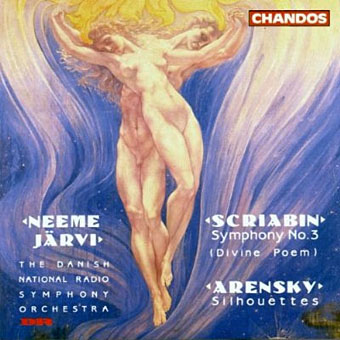
Scriabin: Symphony no 3; Arensky: Silhouettes (1992) by Neeme Järvi.
The Delville painting from yesterday’s post seems popular with classical recordings, this is only one example of its use, chosen here because some of the music is Scriabin for whom Delville created a sheet music illustration in 1912. Delville’s other work is understandably popular in the metal world among whose adherents there’s now a kind of tradition for using interesting paintings as album art. Examples of some of these follow.
The Treasures of Satan (1895).
Morbid Angel beat everyone to Delville’s masterwork. I wrote something about using the same painting on a book cover design here.
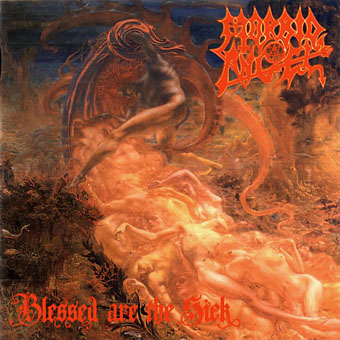
Blessed Are The Sick (1991) by Morbid Angel.
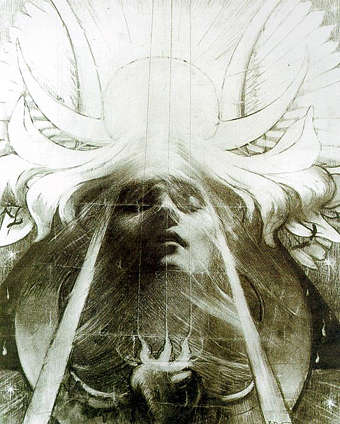
Parsifal (1890).
Another very popular Delville image, that face was used by Stanley Mouse in a poster design in 1991, and even crept into my adaptation of The Call of Cthulhu.
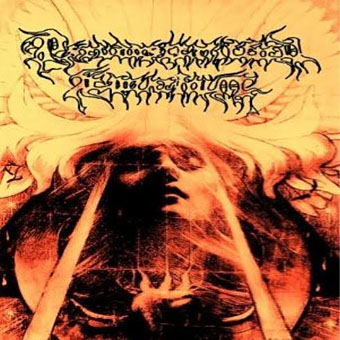
Into The Flames (2004) by Pseudostratified Epithelium.
Pseudostratified Epithelium are a death metal band from Costa Rica. A shame they stretched Delville’s drawing; The Everdawn make a better fist of it.
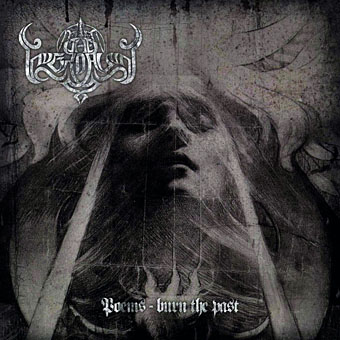
Poems – Burn The Past (2012) by The Everdawn.
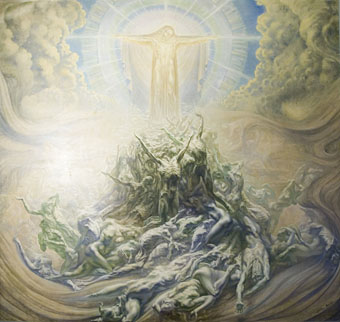
L’Homme-Dieu (1900).
Another popular one for metal bands despite being a piece of Christian mysticism. Everyone gets around that by cropping or otherwise obscuring the Christ figure.
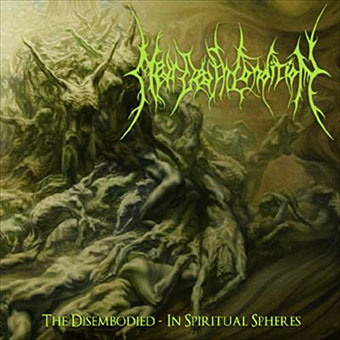
The Disembodied – In Spiritual Spheres (2011) by Near Death Condition.
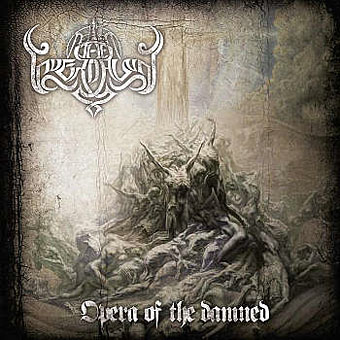
Opera Of The Damned (2012) by The Everdawn.
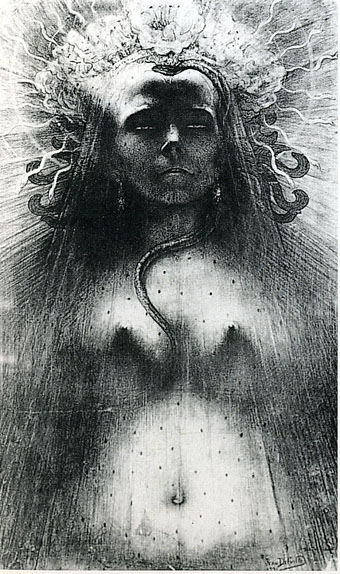
The Idol of Perversity (1891).
One of my favourite Delville drawings which these days always makes me think of Björk; I can’t decide whether she’d be flattered by the comparison. This is also a kind of sinister opposite of the Parsifal drawing. Lisa Hammer’s album is classed by Discogs as “Tribal, Drone, Medieval, Ambient, Romantic”, and includes a setting of The Valley of Unrest by Edgar Allan Poe.
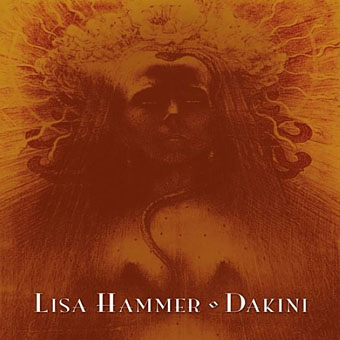
Dakini (2009) by Lisa Hammer.
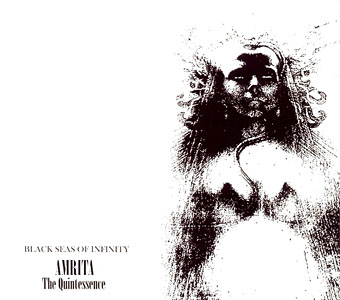
above and below: Amrita – The Quintessence (2007) by Black Seas Of Infinity.
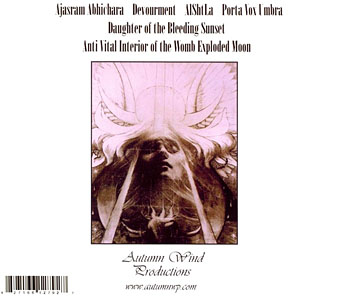
Elsewhere on { feuilleton }
• The album covers archive
Previously on { feuilleton }
• L’amour des âmes
• Philippe Jullian, connoisseur of the exotic
• Delville, Scriabin and Prometheus
• The faces of Parsifal
• Masonic fonts and the designer’s dark materials
• Angels 4: Fallen angels

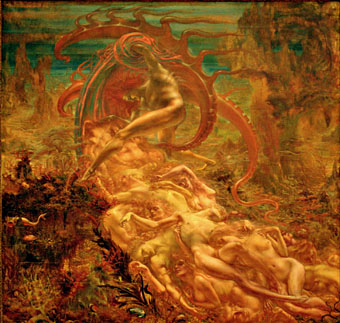
Both Parsifal and the Idol of Perversity were also used in ‘Armrita – The Quintessence’ by an ambient project called Black Seas of Infinity, along with a few drawings by Andrew Chumbley. By far their best album.
Thanks, I would have been surprised if there weren’t more uses of those drawings. I’ve added them above. One problem with Discogs is they don’t always list artwork credits.
I love the illegible, symmetrical logos that are the hallmark of extreme metal. It’s this weird graphical dialect that has developed from obvious historical precedents into its own thing.
Delville treats Parsifal as he previously did Orpheus, with a youth’s head grafted onto a lyre. This seems to stem from the mythological theme of the instrument made from a sacrificed being and carrying its voice (e.g. Pentangle, Cruels Sister) more than the Orpheus myth itself. The connection between Parsifal and Orpheus escapes me.
This doesn’t have so much to do with music John, but Delville reminds me of him. Have you ever seen artwork by Denis Forkas Kostromitin? Very much a modern symbolist equal to Delville, and maybe I am crazy, but I do think he is just as good. His art has been used on a lot of covers as well, and I’ve noticed Fulgur Ltd. has a page dedicated to him. Hopefully we’ll see a book sooner rather than later.
Michelangelo: The lettering on psychedelic posters had a similar effect, being intended solely for initiates not squares. As for Parsifal, the descending lines may be a veil or something similar; Delville’s Idol of Perversity appears to be wearing a veil judging by the lines and spots over her body.
Wiley: No, I’d not seen his work before so that’s another good tip, thanks. Reminds me as much of Wayne Barlowe’s Inferno paintings as Delville (and Austin Spare) although it wouldn’t be a bad thing to combine all of those.
Ah yes, Barlowe. In spite of the fact that his interpretation of the underworld is very much black&white monotheistic, fallen angel-type popular tripe, visually I fail to think of another who does a more fascinating Inferno. Although there are a few sketches I’ve seen on Kostromitin’s Facebook (ugh!) page labeled with familiar names like Geryon, he may well be able to rival or even surpass Barlowe in this visionary-type regard if he devoted himself to just the Inferno. However there is a more playful undercurrent to the Russian’s work, as intimidating and mysterious as they can be, have you seen the Behemoth picture? Kostromitin appears, for me at least, have more in common with a Jung as opposed to a Rasputin, I doubt he would devote as much time to the subject as Barlowe has, and continues doing so, and for a while I hope. I have both of his Hell-related ‘books’ and several of his best paintings in this arena are newer pieces that are present in neither.
I like Barlowe’s work for his imagination and technique but can’t accept his timid (or even prudish) approach to sex. He tries to evade the issue by saying that sex is banned in Hell but when sexual violence is such a universal fear–and is even present in medieval church art–it makes no sense that the massed legions of Hell wouldn’t use a nightmarish sexuality to torment the damned. He may show Lilith grabbing her breasts but her pubis is as featureless as Bouguereau’s Venus. Hollywood has the same problem: monsters can be endlessly brutal and violent but don’t dare give them a sexual appetite.